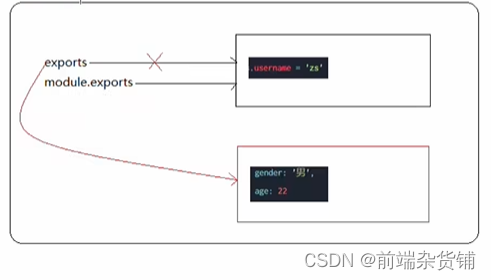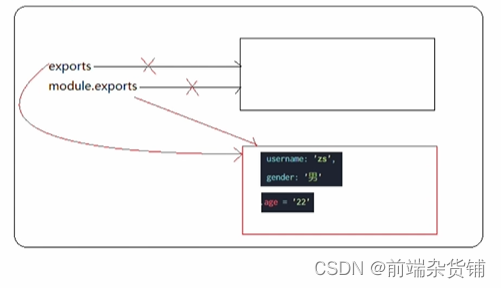个人简介
👀个人主页: 前端杂货铺
🙋♂️学习方向: 主攻前端方向,也会涉及到服务端
📃个人状态: 在校大学生一枚,已拿 offer(秋招)
🥇推荐学习:🍍前端面试宝典 🍉Vue2 🍋Vue3 🍓Vue2&Vue3项目实战 🥝Node.js
🌕个人推广:每篇文章最下方都有加入方式,旨在交流学习&资源分享,快加入进来吧
Node.js系列文章目录
| 内容 | 参考链接 |
|---|---|
| Node.js(一) | 初识 Node.js |
| Node.js(二) | Node.js——文件模块和路径模块 |
文章目录
- Node.js系列文章目录
-
- 一、http 模块
-
- 1、创建 web 服务器
- 2、req 请求对象
- 3、res 响应对象
- 4、解决中文乱码问题
- 5、根据不同的 url 响应不同的 html 内容
- 二、Node.js 中的模块分类
-
- 1、三大模块分类
- 2、模块作用域
- 3、module.exports 对象
- 4、共享成员时的注意点
- 5、exports 和 module.exports
一、http 模块
http 模块是 Node.js 官方提供的、用来创建 web 服务器的模块。
通过 http 模块提供的 http.createServer() 方法,就能方便的把一台普通的电脑,变成一台 web 服务器,从而对外提供 web 资源服务。
1、创建 web 服务器
- 导入 http 模块
- 创建 web 服务器实例
- 为服务器实例绑定 request 事件,监听客户端的请求
- 启动服务器
示例:监听 8080 服务
// 导入 http 模块
const http = require('http')
// 创建 web 服务器实例
const server = http.createServer()
// 为服务器实例绑定 request 事件 监听客户端的请求
server.on('request', function (req, res) {
console.log('请求中...')
})
// 启动服务
server.listen(8080, function () {
console.log('http://127.0.0.1:8080')
})

2、req 请求对象
只要服务器接收到了客户端的请求,就会调用通过 server.on() 为服务器绑定的 request 事件处理函数
示例:在事件处理函数中,访问与客户端相关的数据或属性
// 导入 http 模块
const http = require('http')
// 创建 web 服务器实例
const server = http.createServer()
// req 是请求对象 包含了与客户端相关的数据和属性
server.on('request', (req) => {
// req.url 客户端请求的 url 地址
const url = req.url
// req.method 是客户端请求的 method 类型
const method = req.method
const str = `Your request url is ${url} and request method is ${method}`
console.log(str)
})
// 启动服务
server.listen(8080, function () {
console.log('http://127.0.0.1:8080')
})

3、res 响应对象
在服务器的 request 事件处理函数中,如果想访问与服务器相关的数据或属性,需要使用 response
示例:请求响应
// 导入 http 模块
const http = require('http')
// 创建 web 服务器实例
const server = http.createServer()
// req 是请求对象 包含了与客户端相关的数据和属性
server.on('request', (req, res) => {
// req.url 客户端请求的 url 地址
const url = req.url
// req.method 是客户端请求的 method 类型
const method = req.method
const str = `Your request url is ${url} and request method is ${method}`
console.log(str)
// 调用 res.end() 方法 向客户端响应一些内容
res.end(str)
})
// 启动服务
server.listen(8080, function () {
console.log('http://127.0.0.1:8080')
})


4、解决中文乱码问题
当调用 res.end() 方法,向客户端发送中文内容时,会出现乱码问题,需要手动设置内容的编码格式
示例:解决中文乱码
// 导入 http 模块
const http = require('http')
// 创建 web 服务器实例
const server = http.createServer()
// req 是请求对象 包含了与客户端相关的数据和属性
server.on('request', (req, res) => {
// req.url 客户端请求的 url 地址
const url = req.url
// req.method 是客户端请求的 method 类型
const method = req.method
const str = `请求地址是 ${url} 请求方法是 ${method}`
console.log(str)
// 设置 Content-Type 响应头 解决中文乱码问题
res.setHeader('Content-Type', 'text/html; charset=utf-8')
// 调用 res.end() 方法 向客户端响应一些内容
res.end(str)
})
// 启动服务
server.listen(8080, function () {
console.log('http://127.0.0.1:8080')
})


5、根据不同的 url 响应不同的 html 内容
示例:步骤如下
- 获取请求的 url 地址
- 设置默认的响应内容为 404 Not found
- 判断用户请求的是否为 / 或 /index.html 首页
- 判断用户请求的是否为 /about.html 关于页面
- 设置 Content-Type 响应头,防止中文乱码
- 使用 res.end() 把内容响应给客户端
// 导入 http 模块
const http = require('http')
// 创建 web 服务器实例
const server = http.createServer()
// req 是请求对象 包含了与客户端相关的数据和属性
server.on('request', (req, res) => {
// req.url 客户端请求的 url 地址
const url = req.url
// 设置默认的内容为 404 Not Found
let content = '<h1>404 Not Found!</h1>'
// 用户请求页是首页
if(url === '/' || url === '/index.html') {
content = '<h1>首页</h1>'
} else if (url === '/about.html') {
content = '<h1>关于页面</h1>'
}
// 设置 Content-Type 响应头 防止中文乱码
res.setHeader('Content-Type', 'text/html; charset=utf-8')
// 调用 res.end() 方法 向客户端响应一些内容
res.end(content)
})
// 启动服务
server.listen(8080, function () {
console.log('http://127.0.0.1:8080')
})





二、Node.js 中的模块分类
1、三大模块分类
- 内置模块:由 node.js 官方提供的,如 fs、path、http 等
- 自定义模块:用户创建的每个 .js 文件,都是自定义模块
- 第三方模块:由第三方开发出来的模块,使用前要先下载
2、模块作用域
防止了全局变量污染的问题
示例:
index.js 文件
const username = '张三'
function say() {
console.log(username);
}
test.js 文件
const custom = require('./index')
console.log(custom)

3、module.exports 对象
在自定义模块中,可以使用 module.exports 对象,将模块内的成员共享出去,供外界使用。
外界 require() 方法导入自定义模块时,得到的就是 module.exports 所指向的对象
示例:
index.js 文件
const blog = '前端杂货铺'
// 向 module.exports 对象上挂载属性
module.exports.username = '李四'
// 向 module.exports 对象上挂载方法
module.exports.sayHello = function () {
console.log('Hello!')
}
module.exports.blog = blog
test.js 文件
const m = require('./index')
console.log(m)

4、共享成员时的注意点
使用 require() 方法导入模块时,导入的结果,永远以 module.exports 指向的对象为准
示例:
index.js 文件
module.exports.username = '李四'
module.exports.sayHello = function () {
console.log('Hello!')
}
// 让 module.exports 指向一个新对象
module.exports = {
nickname: '张三',
sayHi() {
console.log('Hi!')
}
}
test.js 文件
const m = require('./index')
console.log(m)

5、exports 和 module.exports
默认情况下,exports 和 module.exports 指向同一个对象。
最终共享的结果,还是以 module.exports 指向的对象为准。
示例:
index1.js 文件
exports.username = '杂货铺'
module.exports = {
name: '前端杂货铺',
age: 21
}

index2.js 文件
module.exports.username = 'zs'
exports = {
gender: '男',
age: 22
}

index3.js 文件
exports.username = '杂货铺'
module.exports.age = 21
![]()
index4.js 文件
exports = {
gender: '男',
age: 21
}
module.exports = exports
module.exports.username = 'zs'

对 index2.js 文件结果的解析如下:

对 index4.js 文件结果的解析如下:

注意:为防止混乱,尽量不要在同一个模块中同时使用 exports 和 module.exports
